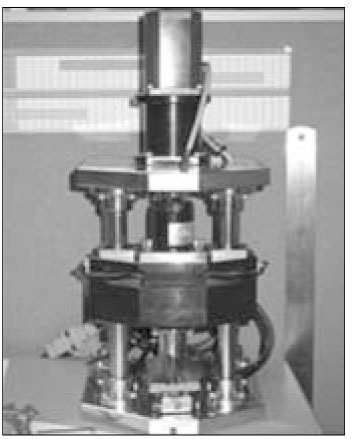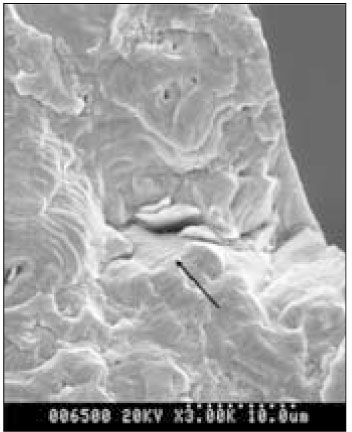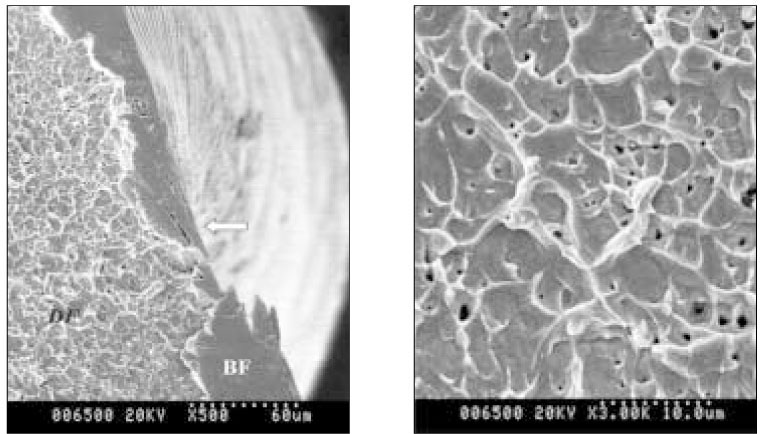The Effect of Surface Defects on the Cyclic Fatigue Fracture of HEROShaper Ni-Ti rotary files in a Dynamic Model: A Fractographic Analysis
- Affiliations
-
- 1Department of Conservative Dentistry, Oral Science Research Center, Yonsei University, Korea.
- 2Department of Conservative Dentistry, Dental Research Institute, Seoul National University, Korea. kum6139@snu.ac.kr
- KMID: 2175846
- DOI: http://doi.org/10.5395/JKACD.2007.32.2.130
Abstract
- This in vitro study examined the effect of surface defects on cutting blades on the extent of the cyclic fatigue fracture of HEROShaper Ni-Ti rotary files using fractographic analysis of the fractured surfaces. A total of 45 HEROShaper (MicroMega) Ni-Ti rotary files with a #30/.04 taper were divided into three groups of 15 each. Group 1 contained new HEROShapers without any surface defects. Group 2 contained HEROShapers with manufacturing defects such as metal rollover and machining marks. Group 3 contained HEROShapers that had been clinically used for the canal preparation of 4-6 molars. A fatigue-testing device was designed to allow cyclic tension and compressive stress on the tip of the instrument whilst maintaining similar conditions to those experienced in a clinic. The level of fatigue fracture time was measured using a computer connected the system. Statistical analysis was performed using a Tukey's test. Scanning electron microscopy (SEM) was used for fractographic analysis of the fractured surfaces. The fatigue fracture time between groups 1 and 2, and between groups 1 and 3 was significantly different (p < 0.05) but there was no significant difference between groups 2 and 3 (p > 0.05). A low magnification SEM views show brittle fracture as the main initial failure mode. At higher magnification, the brittle fracture region showed clusters of fatigue striations and a large number of secondary cracks. These fractures typically led to a central region of catastrophic ductile failure. Qualitatively, the ductile fracture region was characterized by the formation of microvoids and dimpling. The fractured surfaces of the HEROShapers in groups 2 and 3 were always associated with pre-existing surface defects. Typically, the fractured surface in the brittle fracture region showed evidence of cleavage (transgranular) facets across the grains, as well as intergranular facets along the grain boundaries. These results show that surface defects on cutting blades of Ni-Ti rotary files might be the preferred sites for the origin of fatigue fracture under experimental conditions. Furthermore, this work demonstrates the utility of fractography in evaluating the failure of Ni-Ti rotary files.
Keyword
Figure
Cited by 4 articles
-
Comparative analysis of various corrosive environmental conditions for NiTi rotary files
Ji-Wan Yum, Jeong-Kil Park, Bock Hur, Hyeon-Cheol Kim
J Korean Acad Conserv Dent. 2008;33(4):377-388. doi: 10.5395/JKACD.2008.33.4.377.Stress distribution for NiTi files of triangular based and rectangular based cross-sections using 3-dimensional finite element analysis
Hyun-Ju Kim, Chan-Joo Lee, Byung-Min Kim, Jeong-Kil Park, Bock Hur, Hyeon-Cheol Kim
J Korean Acad Conserv Dent. 2009;34(1):1-7. doi: 10.5395/JKACD.2009.34.1.001.Effect of internal stress on cyclic fatigue failure in .06 taper ProFile
Hye-Rim Jung, Jin-Woo Kim, Kyung-Mo Cho, Se-Hee Park
Restor Dent Endod. 2012;37(2):79-83. doi: 10.5395/rde.2012.37.2.79.Effect of internal stress on cyclic fatigue failure in K3
Jun-Young Kim, Jin-Woo Kim, Kyung-Mo Cho, Se-Hee Park
Restor Dent Endod. 2012;37(2):74-78. doi: 10.5395/rde.2012.37.2.74.
Reference
-
1. Esposito PT, Cunningham CJ. A comparison of canal preparation with nickel-titanium and stainless steel instruments. J Endod. 1995. 21:173–176.
Article2. Peters OA. Current challenges and concepts in the preparation of root canal systems: a review. J Endod. 2004. 30:559–567.
Article3. Kum KY, Spangberg LSW, Cha YB, Jung IY, Lee SJ, Lee CY. Shaping ability of three ProFile rotary instrumentation techniques in simulated resin root canals. J Endod. 2000. 26:719–723.
Article4. Pruett JP, Clement DJ, Carnes DL. Cyclic fatigue testing of nickel-titanium endodontic instruments. J Endod. 1997. 23:77–85.
Article5. Bahia MGA, Buono VTL. Decrease in the fatigue resistance of nickel-titanium rotary instruments after clinical use in curved root canals. Oral Surg Oral Med Oral Pathol Oral Radiol Endod. 2005. 100:249–255.
Article6. Bahia MGA, Martins RC, Gonzalez BM, Buono VTL. Physical and mechanical characterization and the influence of cyclic loading on the behavior of Ni-Ti wires employed in manufacture of rotary endodontic instruments. Int Endod J. 2005. 38:795–801.
Article7. Bahia MGA, Melo MCC, Buono VTL. Influence of simulated clinical use on the torsional behavior of nickel-titanium rotary endodontic instruments. Oral Surg Oral Med Oral Pathol Oral Radiol Endod. 2006. 101:675–680.
Article8. Ullmann CJ, Peters OA. Effect of cyclic fatigue on static fracture loads in ProTaper nickel-titanium rotary instruments. J Endod. 2005. 31:183–186.
Article9. Schrader C, Peters OA. Analysis of torque and force with differently tapered rotary endodontic instruments in vitro. J Endod. 2005. 31:120–123.
Article10. Haïkel Y, Serfaty R, Bateman G, Senger B, Alleman C. Dynamic and cyclic fatigue of engine-driven rotary nickel-titanium endodontic instruments. J Endod. 1999. 25:434–440.
Article11. Tripi TR, Bonaccorso A, Condorelli GG. Cyclic fatigue of different nickel-titanium endodontic rotary instruments. Oral Surg Oral Med Oral Pathol Oral radiol Endod. 2006. 102:e106–e114.
Article12. Peters OA, Barbakow F. Dynamic torque and apical forces of ProFile 04 rotary instruments during preparation of curved canals. Int Endod J. 2002. 35:379–389.
Article13. Zelada G, Varela P, Martin B, Bahilo JG, Magan F, Ahn S. The effect of rotational speed and the curvature of root canals on the breakage of rotary endodontic instruments. J Endod. 2002. 28:540–542.
Article14. Xu X, Zheng Y, Eng D. Comparative study of torsional and bending properties for six models of nickel-titanium root canal instruments with different cross-sections. J Endod. 2006. 32:372–375.
Article15. Li UM, Lee BS, Shih CT, Lan WH, Lin CP. Cyclic fatigue of endodontic nickel-titanium rotary instruments: Static and dynamic tests. J Endod. 2002. 28:448–451.
Article16. Shin YM, Kim ES, Kim KM, Kum KY. Effect of surface defects and cross-sectional configurations on the fatigue fracture of Ni-Ti rotary files in a dynamic model. J Korean Acad Conserv Dent. 2004. 29:267–272.
Article17. Alapati SB, Brantley WA, Svec TA, Powers JM, Mitchell JC. Scanning electron microscope observations of new and used nickel-titanium rotary files. J Endod. 2003. 29:667–669.
Article18. Kuhn G, Tavernier B, Jordan L. Influence of structure on Ni-Ti endodontic instrument failure. J Endod. 2001. 27:516–520.19. Eggert C, Peters O, Barbacow F. Wear of nickel-titanium Lightspeed instruments by scanning electron microscopy. J Endod. 1999. 25:494–497.
Article20. Tripi TR, Bonaccorso A, Tripi V, Condorelli GG, Rapisardo E. Defects in GT rotary instruments after use. An SEM study. J Endod. 2001. 27:782–785.
Article21. Cheung GSP, Peng B, Bian Z, Shen Y, Darwell BW. Defects in ProTaper S1 instruments after clinical use: fractographic examination. Int Endod J. 2005. 38:802–809.
Article22. Yao JH, Schwartz SA, Beeson TJ. Cyclic fatigue of three types of rotary nickel-titanium files in a dynamic model. J Endod. 2006. 32:55–65.
Article23. Hull D. Fractography: Observing, measuring and interpreting fracture surface topography. 1999. Cambridge. United Kingdom: Cambridge University Press.24. Parrington RJ. Fractography of metals and plastics. Pract Fail Anal. 2002. 2:16–46.
Article25. Schneider SW. A comparison of canal preparations in straight and curved canals. Oral Surg. 1971. 32:271–275.26. Fife D, Gambarini G, Britto LR. Cyclic fatigue testing of ProTaper Ni-Ti rotary instruments after clinical use. Oral Surg Oral Med Oral Pathol Oral Radiol Endod. 2004. 97:251–256.
Article27. Karn TA, Kelly FC, Eichmiller FC, Spnagberg LSW. Fracture behavior of Ni-Ti rotary endodontic instruments. J Dent Res. 2004. #2684.28. Spanaki-Voreadi AP, Kerezoudis NP, Zinelis S. Failure mechanism of ProTaper Ni-Ti rotary instruments during clinical use: fractographic analysis. Int Endod J. 2006. 39:171–178.
Article29. Duerig T, Pelton A, Stockel D. An overview of nitinol medical applications. Mater Sci Eng A Struct Mater. 1999. 273-275:149–160.
Article30. Karn T. Fractographic and microstructual analysis of separated Ni-Ti rotary files. 2003. University of Connecticut;MS thesis.31. Callister WD. Materials science and engineering. An introduction. 2000. New York: John Wiley & Sons, Inc;223–224.32. Alapati SB, Brantley WA, Svec TA, Powers JM, Nusstein JM, Daehn GS. Proposed role of embedded dentin chips for the clinical failure of nickel-titanium rotary instruments. J Endod. 2004. 30:339–341.
Article
- Full Text Links
- Actions
-
Cited
- CITED
-
- Close
- Share
- Similar articles
-
- Effect of cross-sectional area of 6 nickel-titanium rotary instruments on the fatigue fracture under cyclic flexural stress: A fractographic analysis
- Effect of surface defects and cross-sectional configuration on the fatigue fracture of NiTi rotary files under cyclic loading
- Cyclic fatigue resistance of M-Pro and RaCe Ni-Ti rotary endodontic instruments in artificial curved canals: a comparative in vitro study
- Cyclic fatigue, bending resistance, and surface roughness of ProTaper Gold and EdgeEvolve files in canals with single- and double-curvature
- Cyclic fatigue of the sodium hypochlorite treated and/or steam autoclaved nickel-titanium endodontic files





